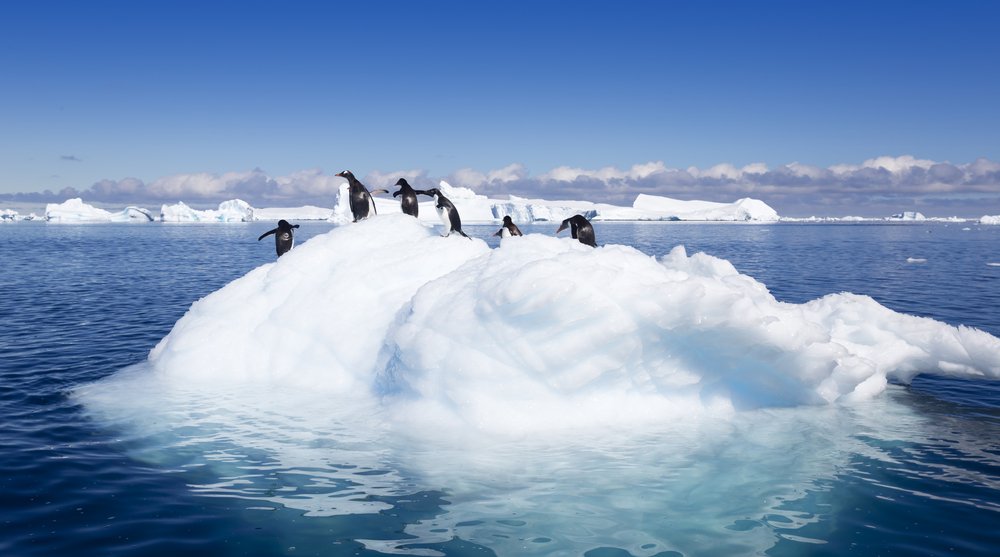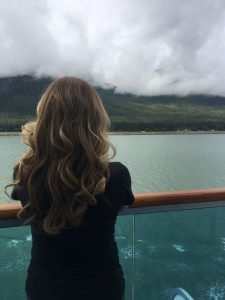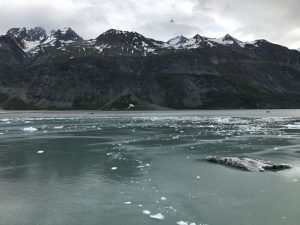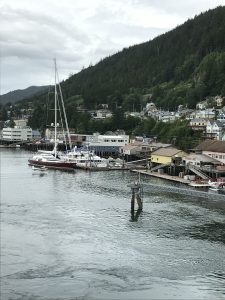Cruising to Vacation Success with Adequate Preparation


Earlier this month, I was fortunate to enjoy a beautiful cruise through the inside passage of Alaska.
Having done my due diligence (see “Cruising Solutions“), I was prepared with an over-the-counter medication, as well as some extra baclofen. Both were recommended by my pharmacist to help curb any motion sickness on the ship. I purchased my Bonine (meclizine hydrochloride), along with three bags of ginger chews and some Larabars at a local store. I did not fully understand my pharmacist’s explanation of how baclofen would help.
Internet snooping led me to this article about motion sickness and baclofen. Perhaps one of you can tell me what it says? Despite reading a few scientific articles (or perhaps because of it), I remained unclear on the pharma-physiology. However, I was excited to learn we have “velocity storage integrators” in our heads! Doesn’t that sound very Back to the Future? So much untapped potential … if only I could get my VSI to sync up with my aVOR! Right? I decided some extra baclofen was worth a try.

Enjoying our balcony view. (Photo by Judy Lynn)
My mother, sister, and I shared a cabin that was mid-ship to minimize the feeling of rolling, pitching, and yawing. That’s right, the movement of a ship has three special names because “lurching,” as I like to say, just doesn’t cut it. Our first evening at sea, as we attended a rocking (both musically and physically) performance in the theater at the front of the boat, I was thankful for our stable “home away from home” in the middle of the boat.
I needed my seasickness medications three of the seven days at sea. Meclizine, while still an antihistamine, is considered less likely to cause drowsiness than Dramamine. I have established a reasonable tolerance to the fatigue effects of baclofen and had no need to operate heavy machinery onboard, so I was able to add that to the daytime regime as well. Thanks to an ample supply of coffee, lots of fresh air, and the fun of vacation, the additional dosing did not make me sleepy.
After “Cruising Solutions” was published, several helpful readers wrote to me with great advice. I acted on most of their suggestions, as well as what I found doing my own research. Some of the best vertigo-aversion tips included:
- Choose a cabin mid-ship. We were directly between the bow and stern. Our cabin was on a higher deck than recommended, but we wanted to avoid being adjacent to activity areas.
- Have a balcony to step onto and get some fresh air. Or at least a window to open.
- If you feel queasy, try staring at a fixed point on the horizon.
-

Glacier Bay National Park. (Photo by Judy Lynn)
Hold onto railings or just run your hand along the railing or wall while you are walking. This seems to help with proprioception and vertigo.
- Stay hydrated. Drink lots and lots of water. I failed at this on our second day and I felt the difference.
- Take your medicine and stay ahead of the problem. Similar to pain meds, motion sickness meds work better if you take them before you are desperate.
- Face forward. I had to switch sides of the table in the dining room one day, just so I didn’t feel like I was cruising backward.
- Eat small, frequent meals. An empty stomach is more prone to become upset. That’s what the Larabars were for. And, as delightful as the “all you can eat” free food is, I found that I had to avoid rich, fatty, or overly sweet foods.
- Ginger chews worked great for all of us. The motion sickness bracelets were helpful the first day, but I found that they aggravated nerve pain in my arm.

Ketchikan, Alaska. (Photo by Judy Lynn)
Cruising is an excellent way to travel for those with MS. There are activities for every ability and energy level, and plans can be easily changed. Bathrooms, water, and chairs are always nearby. A person can sneak back to the cabin for a nap while fellow travelers carry on. And it’s a way to see many different places without having to re-pack your suitcase five times.
The beauty of an Alaskan cruise (aside from glaciers, mountains, wildlife, forests, waterfalls, and lakes) is that there is no danger of heat-related MS symptoms interfering. I am so thankful for the wisdom of those who have cruised before me. Both of my MS’s (multiple sclerosis and motion sickness) behaved themselves for the week and I was able to relax, have fun, and soak up the beautiful Alaskan scenery.
***
Note: Multiple Sclerosis News Today is strictly a news and information website about the disease. It does not provide medical advice, diagnosis, or treatment. This content is not intended to be a substitute for professional medical advice, diagnosis, or treatment. Always seek the advice of your physician or other qualified health provider with any questions you may have regarding a medical condition. Never disregard professional medical advice or delay in seeking it because of something you have read on this website. The opinions expressed in this column are not those of Multiple Sclerosis News Today, or its parent company, Bionews Services, and are intended to spark discussion about issues pertaining to multiple sclerosis.







Leave a comment
Fill in the required fields to post. Your email address will not be published.